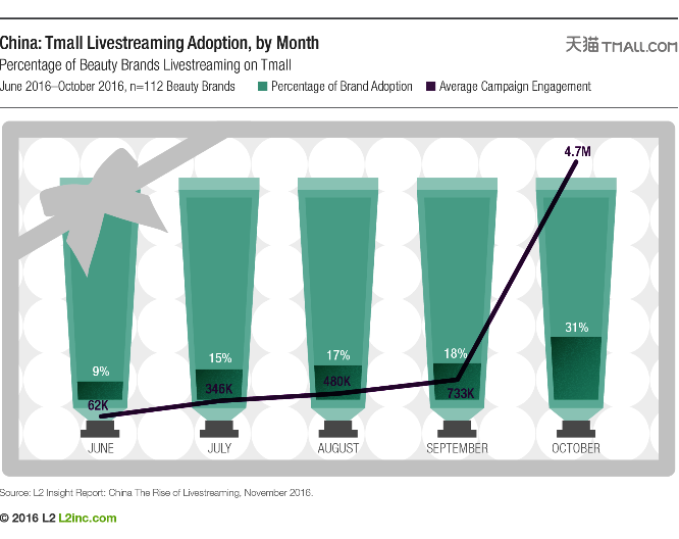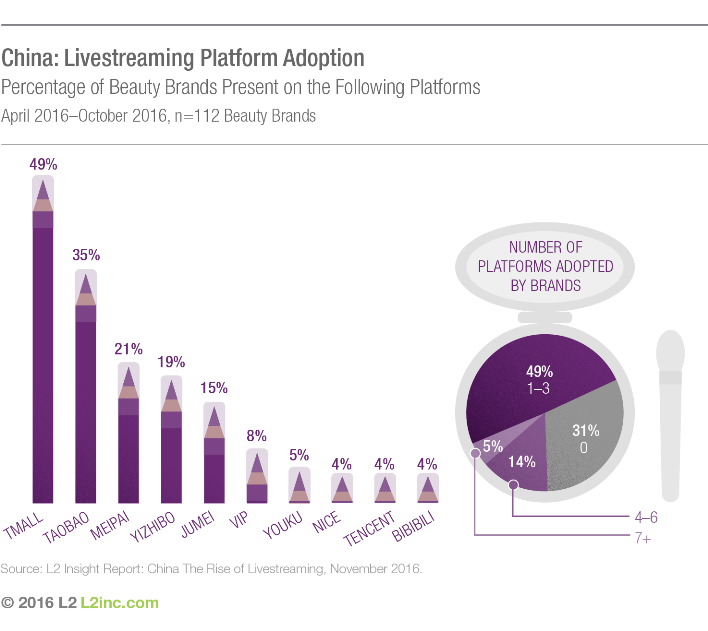
The use of live stream videos to promote brands and products is “exploding” in China, says a recent report from L2, a U.S. business intelligence firm specializing in measuring the digital performance of consumer brands.
Barely on anyone’s radar a year ago, watching live stream videos is rapidly becoming a mainstream activity for mobile-savvy millennials who “crave interactive, real-time and reality content,” according to the L2 report. Seeking innovative, social ways to engage new customers and sell more products, merchants are responding. Nearly 70 percent of more than 100 beauty brands with China operations are using live streaming as a marketing and advertising tool, says L2, and more consumer brands are jumping on the bandwagon every day.
To find out more about this uniquely Chinese phenomenon, Alizila interviewed Danielle Bailey, who leads L2’s Asia-Pacific practice. Here’s what she had to say about live streaming in China and how it’s different than real-time videos in the U.S.:
How would you explain live streaming in China to someone unfamiliar with the medium?
In layman’s jargon I’d call it “QVC on crack,” although it’s probably not appropriate [laughs]. It’s a very similar model to home-shopping channels, using live video typically with a host, either a KOL [Key Opinion Leader, e.g. a popular vblogger] or a paid celebrity actor. It’s online home shopping with the ability to purchase directly from the video in a seamless way that really doesn’t exist in the West. In China, live-streamed videos are designed to sell products, and that intention is very clear throughout. This is different from the West, where we may find this approach a little heavy handed.
Is live streaming even a “thing” in the U.S.?
It is a thing, but not the same thing. In the U.S., people are streaming events, performances, concerts, panel discussions. But they are not taking it the next step by saying ‘OK let’s generate some sales off this.’ China is ahead in this area. In China they are connecting entertainment and commerce online in a way that people haven’t figured out how to do well elsewhere.
You say in your report that live streaming is booming in China. Why?
We’re looking at it strictly from the perspective of brands, but various participants are getting something out of this phenomenon. Brands are obviously getting exposure and generating sales, the celebrities and the hosts are obviously being compensated. Specifically for the cyber-celebrities or the KOLs, they can make significant money. Then from the consumer perspective, they are entertained and also informed about individual products.
Chinese consumers aren’t just passively watching, right? They are actually buying products they see and otherwise interacting socially through shows streamed online.
The engagement possibilities between the host of the live stream and viewers is super important. During a show, viewers can have their questions answered by someone in the comments section or by the host, and they can even have a personalized communication with a celebrity. It’s definitely social, and it’s also a form of entertainment, one that is replacing traditional television in many respects. Chinese consumers spend a significant amount of time online, on their smartphones, consuming videos. Live streaming is a natural extension of this for the purposes of commerce.
Consumers are comfortable buying products online based on celebrity pitches?
In general Chinese consumers are more comfortable with online shopping. The percentage of goods bought online is higher in China, approaching something like 18 percent of total retail sales compared with around 10 or 12 percent in the U.S. There’s still a trust barrier, but live streaming is a way for consumers to learn more about products they are interested in, gaining some understanding and trust in what they are actually buying.
This is consistent with what we’ve seen in the Chinese market in terms of the power of celebrities to drive engagement, to drive social interaction, and obviously just to attract eyeballs. Celebrities are a huge influence and a huge determiner of purchasing habits in a way that they are not in the U.S.
How does live streaming compare with other forms of marketing and advertising?
Take television advertising. It’s expensive, yet it can be very hard to quantify what you actually get out of it. With live streaming, the ability to measure far exceeds anything you can do with traditional television. You can get a precise count of how many people were engaged, you can link to their purchasing histories and other things that they’ve done with you on the [e-commerce] platform, you get direct feedback from consumers about your products, what works, what doesn’t work. And you can get a direct conversion measure of how many people bought your product that you don’t get with television advertising or sponsorship. Paying celebrities to be brand ambassadors is another huge expense for brands, and now they have a direct way to monetize that. This is direct sales generation, and that’s a big deal.
What are the leading platforms for live streaming?
There are something like 150 different live streaming platforms that have cropped up in China. It’s a highly fragmented space. When we looked at where brands are investing, we found it’s mostly with online retailing platforms. Half of the 112 beauty brands we evaluated were doing some form of live streaming on Tmall and a little more than a third were active on Taobao. These Alibaba platforms represented the places where we saw the most activity.
We started initial investigation around the April-May timeframe, and then we came back some months later and had seen the number of brands had increased exponentially, which was really saying something. Thirty-one percent of beauty brands ran live-streaming content on Tmall in October 2016—three times more than in June 2016. The period we looked at included the lead-up to Singles’ Day, during which Alibaba was encouraging retailers participation and highly touting the features and functionality and benefits of their live-stream platforms, but still it was very rare to see this speed of adoption.
Why are Tmall and Taobao the most popular live streaming venues?
For brands and especially for online retailers, it makes complete sense. Shopping portals like Tmall and Taobao have these huge audience bases already built into the platform. Trying to marshall that same number of eyeballs in another space can be very difficult.
Plus there’s the integration of the commerce capability, something that many live-streaming platforms don’t offer. Giving shoppers the ability to click on a link while they are watching a video to buy the featured product is key. It exemplifies a ‘see-now, buy-now’ trend that’s happening across China. The assortment of products is already there, and both Taobao and Tmall are doing a good job promoting live-stream events in a consistent way, and surfacing them within their [mobile] apps.
Your report notes that prior to Alibaba’s big 11.11 online sale, Tmall hosted an eight-hour, live-streamed fashion show in Shanghai with 80 global brands. What was unusual about this event?
The first thing was that it was eight hours long! From the beauty perspective, the incorporation of beauty brands within the fashion show as well was super smart. Guerlain used this as their jumping-off point, their launch onto Tmall. It was interesting to see this premium Western brand partnering with Alibaba in this way to introduce itself to the China market. The fashion show was also interesting because it reinforced this ability to order directly from the runway, extending what we think of as entertainment here in the West into commerce. The event made a fashion show into something beyond being a PR play to being a bottom-line play.
How do you see live streaming evolving in China?
Because so many brands are now doing live streams, there is competition for eyeballs in a way that there wasn’t in the beginning, so it becomes more important that you are doing marketing around the event itself. Brands need to promote the promotion, by doing things like getting a celebrity host to post about the upcoming event in their own social media channels, as well as leveraging their own media assets in advance.
How do you bring Chinese consumers to your door without them ever actually leaving their couch? This is a way to introduce people to a brand that they may not have direct exposure to. As more and more brands start to get onto this trend, you’re going to see these live streams go from something less produced to something much more sophisticated and infomercial-like. It’s just one of the many ways in which China, and specifically Alibaba, are taking a medium that might seem sort of gimmicky in the West and turning it into something that can actually drive sales.






